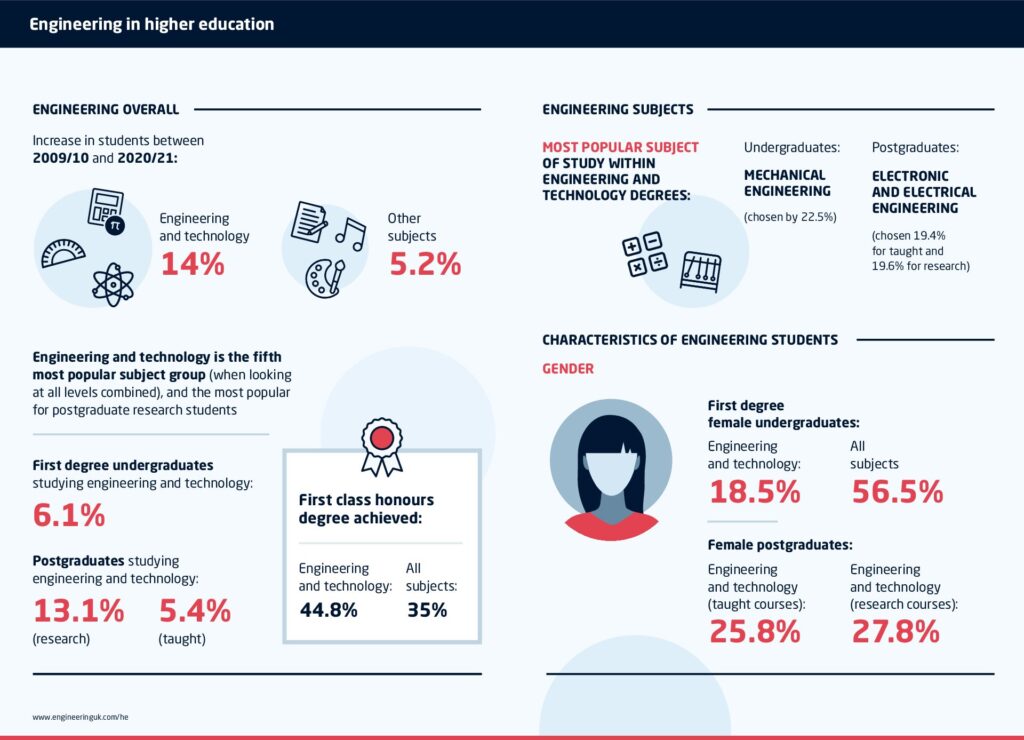An extensive research report from charity EngineeringUK has revealed a “concerning” lack of diversity as it explores the number, characteristics and outcomes of engineering and technology students in higher education.
The report, released on Thursday (16 March) was based on the 2020/21 data from the Higher Education Statistics Agency (HESA), and compares the data for engineering and technology students alongside that of students studying on HE courses overall.
The data reveals that there were 38,615 first-degree engineering and technology undergraduates in their first year of university. This equates to 6.1% of all first-degree undergraduates.
When taking into account undergraduates in all years of study and postgraduates, the number of engineering and technology students rises to 179,000 – which reflects a 14% increase since 2009/10.
This is just under 10% percentage points (pp) higher compared to all subjects – where the number of students has risen by 5.2%. However, when looking at the total number of students it’s important to consider that only a proportion of this group will be graduating and entering the job market each year.

Mixed picture for diversity students
In terms of diversity of students, the report paints a mixed picture. The most concerning diversity issue among engineering and technology students was found to be gender – with only 18.5% of undergraduates being female students.
This is exceptionally low compared to the 56.5% representation seen across all subjects, and is an issue which is mirrored across the engineering and technology workforce.
Concern from lack of ethnic diversity
Lack of ethnic diversity is another concern, with the majority (66.1%) of engineering and technology students being white. Although, this figure is slightly lower than all subjects combined – where over 70% (72.1%) of students are white.
This is a result of the better representation of Asian students in engineering and technology (18% vs 12.7% for all subjects).
However, only 8.1% of engineering and technology students were Black and 4.9% were mixed – which is similar for all subjects (8.3% and 4.8 respectively).
The report also reveals a lack of diversity in terms of disability and social mobility. Only 10.5% of undergraduates have a known disability (vs 15.1% for all subjects) and only 11.2% were from areas with lowest HE participation – quintile 1 (vs 13.5% for all subjects).
Dr Claudia Mollidor, Head of Research & Evaluation at EngineeringUK said: “As with all pathways into engineering and technology careers, it’s really important to understand the numbers and characteristics of students coming through the higher education route.
“Our report highlights a concerning lack of diversity among students, particularly the underrepresentation of women.
“If the UK is going to have a successful and thriving engineering and technology sector, it’s clear we need to do much more to ensure studying engineering and tech appeals to young people from all backgrounds.”
The report also breaks down the numbers and characteristics of students within the 7 principal specialisms of engineering (which are available as standalone inserts). In order of largest uptake among undergraduate students, this includes:
Mechanical engineering (22.5%)
Electrical and electronic engineering (15.8%)
General engineering (15.7%)
Civil engineering (13.7%)
Aeronautical and aerospace engineering (10.0%)
Chemical, process and energy engineering (7.10%)
Production and manufacturing engineering (6.3%)
“Interestingly, the number and diversity of students does differ substantially among these specialisms”, comments Mollidor. “We encourage the sector to pay particular attention to the data breakdown for their area, and consider the impact this might have on its workforce size and what they can do to improve representation.”
The report – ‘Engineering in higher education’ is available to download for free here.
